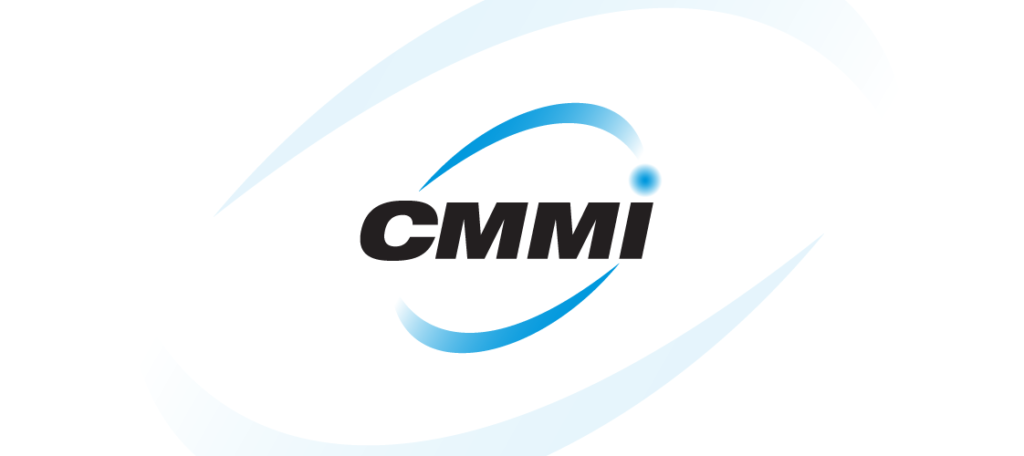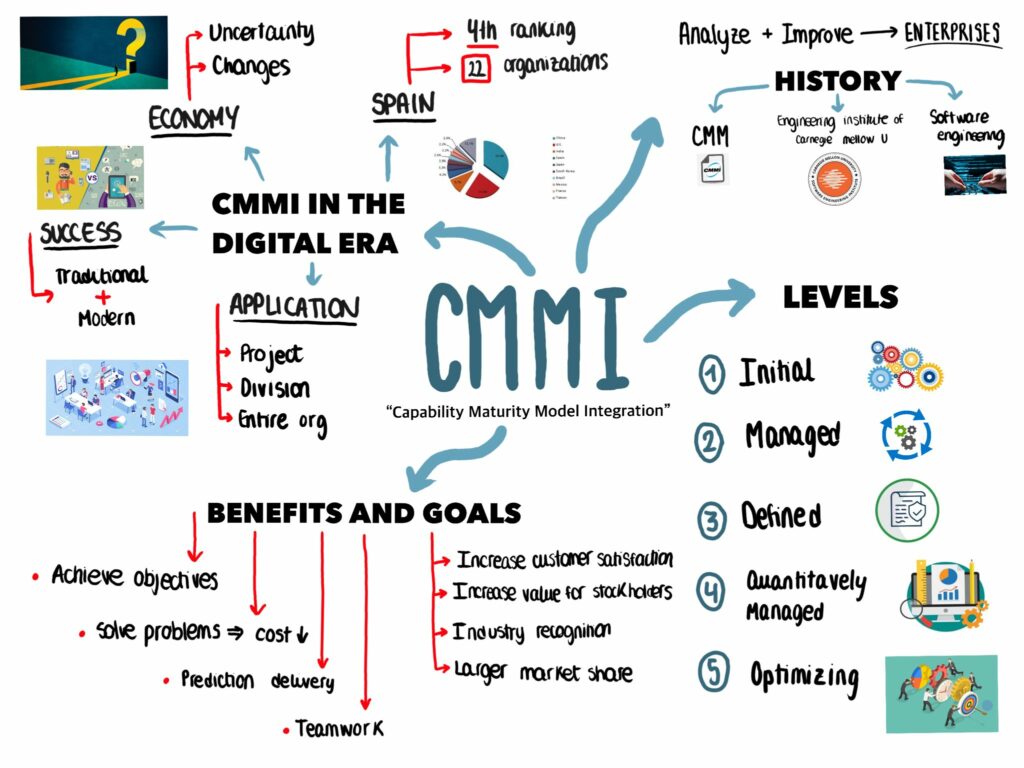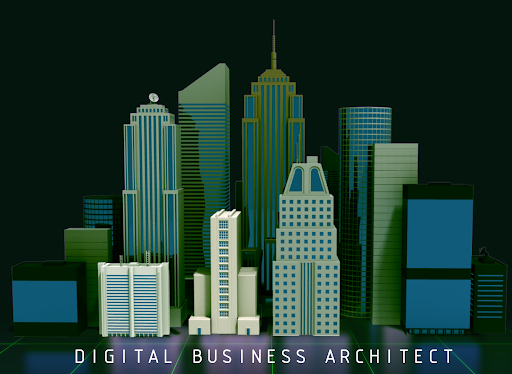How can CMMI be applied to projects in the Digital Era?

Have you ever wondered what CMMI is?
The Capability Maturity Model Integration (CMMI) is a process model that evaluates the practices of an organisation to see how efficient they are. It provides a clear definition of what an organisation should do to promote behaviors that lead to improved performance, productivity, and decreasing risks in product and service development, management, and acquisition.
Its evolution along the years…
The CMMI Integrated Capability Maturity Model is an expansion of the Capability Maturity Model (CMM). “The quality of a system or product is highly influenced by the process used to develop and maintain it.”
This model was created by the Software Engineering Institute of Carnegie Mellon University in the United States. The project, whose main sponsors were the Office of the Secretary of Defense and the National Defense Industrial Association, included members of industry, government, and the Carnegie Mellon Software Engineering Institute. Models were initially created for the Department of Defense to assess the expertise and quality of software contractors. The first version of the CMMI was released in 2002 and built upon the CMM, developed from 1987 to 1997. Initially, it was designed for software engineering. However, the latest version of CMMI is more abstract and generalized, allowing it to be applied to hardware, software and service development across industries. “Its success has been greatly generalized over the years to encompass other business processes, such as hardware product development and service delivery.”
Today, CMMI is used to guide process improvement in a project, the academic says. To do so, it provides companies with a set of guidelines mirziamov.
Which are the maturity levels?
1. Initial
At CMMI Maturity model 1, processes are new and created for providing a solution to a specific problem. Therefore, this process is not usable for other purposes. It is the initial stage for a process you plan to repeat.
2. Managed and repeatable
At this level 2, processes are more generalizable and become repeatable, producing consistent results. All stakeholders involved in the process are given ownership over specific tasks.
3. Defined
When we get to the defined level, your process is well defined with standards, procedures, tools and methods. Therefore, they become more consistent providing reliability and efficiency.
4. Quantitatively managed and capable
At level 4, with the repetition of the process, metrics appear in order to measure the performance of them. This gives the capability to the organization of adapting them to multiple conditions and continuously improving them. All stakeholders that were given a task, are now competent and comfortable with it.
5. Optimizing and efficient
The fifth level should never end as it is a space for continuously monitoring and improving your process, being always flexible to adapt them to new technologies and innovation in the organization.
Let’s talk about the main goals and benefits
The CMMI’s objectives for businesses include enabling the organization to produce quality services or products; increase customer satisfaction; increase value for stockholders; achieve industry-wide recognition for excellence; and build a larger market share.
If we combine all the main objectives, we could group them into a common goal:
To check and verify the quality of the products in order to guarantee functionality, reliability, usability, efficiency, maintainability, portability and conformity.
Benefits
As a model for improving the organization of a company, it has many benefits. Among the most noteworthy we can find:
- Support the business through processes so they can achieve their established objectives.
- As CMMI has the ability to improve the performance of an organization, it helps to solve problems, thus reducing costs or knowing them.
- Improve the prediction of the products and services delivery.
- Increase the teamwork and relationships between the work partners by establishing a better organization explaining to everyone what activities or tasks to perform. This leads to an increase in the productivity of people.
- By improving the quality and efficiency of the services offered by the companies, CMMI helps to enhance and ensure customers a greater level of satisfaction regarding the products/services bought.
Application of the CMMI in the digital era
Almost every business professional states that today’s economy is built upon digital innovation and disruption, along with uncertainty and change. For this reason, in order to have success, improvement in process and performance, as well as staying agile and consistent, is vital, and here is where CMMI enters the picture. Consequently, it is required to adopt tools and strategies that integrate both, traditional and demands of the modern age.
So as to achieve a better position in the curve, businesses should consider implementing digital-first strategies and solutions that match with CMMI together with leveraging the latest technologies and trends.
When talking about the application of this model in the digital era, it is important to have in mind that it can be used to guide innovation process improvement across not only a project, but also a division, or an entire organization. Furthermore, it is capable of integrating the traditional separate organizational functions with the more innovative ones.
Did you know that Spain is the 4th country in the world with the most CMMI certifications?
In the top 5 of the countries with the most organizations holding the CMMI certificate we find: China, US, India, Spain and Japan, as revealed in the presentation of the publication “CMMI for development, version 1.3”.
According to the SEI report published in March 2012, there are 222 Spanish organizations in possession of the CMMI certificate, while this figure was less than 10 in 2005.
Examples of companies using CMMI
Companies are continually looking for models to improve their efficiency and productivity by making changes in the way they organize and carry out processes.
However, the implementation of traditional maturity models is a large investment that is beyond the reach of most small organizations. On the other hand, the CMMI model does not require the same outlay of resources and money as traditional models, which is why it can be applied in both large and small companies.
The most outstanding enterprises using CMMI one are the following:
We can also highlight the company Indra Sistemas, S.A., better known as Indra. It is a multinational Spanish corporation that provides consulting services in transportation, defense, energy, telecommunications, financial services, as well as services to the public sector.
It has been the first company in the Defense and Air Traffic industries to be accredited with the highest quality of its systems in accordance with the new version 2 of the CMMI 5 model.
During this process, Indra has enhanced the tools that support the entire life cycle of the systems and products, from the estimation and management of the project scope and the development and verification of the requirements, to their delivery.
These areas of Indra have adapted to the most advanced work methodologies, such as agile methodologies, which are becoming increasingly in demand, and have also identified aspects to continue evolving and optimizing processes.
This achievement recognizes the great effort made by Indra to maintain the highest levels of quality for its products and processes and to implement a quantitative management that allows it to know, control and predict its processes and to encourage continuous improvement and innovation.
Another example of a Spanish company using this model is GMV.
GMV is a Spanish technology multinational with maturity level 5 according to the Capability Maturity Model Integration. This helps them stand out from their competitors and increases their relevance, as it is a way of recognizing their quality and excellence.
CMMI level 5 brings a series of benefits, among the most outstanding we can find is the achievement of more predictable results in projects or the achievement of improvements in the performance of projects in terms of effort.
Conclusions
Concluding, as we have previously mentioned, CMMI provides lots of benefits. After analyzing the structure and advantages of it, as software architects we would use this model to accompany the path of taking a process from its initial stage to the highest possible efficiency in the latest ones. CMMI provides metrics that help us to know at all times in what stage our process is.
This model will help us to differentiate ourselves by guaranteeing productivity levels in a shorter period of time, thus giving an advantage over the competitors.
When we know in which stage we are, we will realize which are the steps to follow to further optimize the process.
To sum up…

Who are we?
María Ventosa de Bonilla: I´ m a management and technology student from the Carlos III University of Madrid. I consider myself to be a dedicated and responsible person who takes care of those around her. I have a real interest in a wide range of subjects such as finance, the development of new technologies and their subsequent application to the field of business administration and the analysis of competitive strategies of companies.
Alicia Garcia Burgos: The mix of technological and business subjects makes the degree we are taking a perfect combination adapted to the current times.I consider myself a perfectionist and ambitious person and in the future I hope to be able to develop and give value to everything I have learned so far.
Clara Monton Pellejero: Student of Management and Technology at Carlos III University. I consider myself very curious, lover of new experiences and eager to get involved in new projects.
Sofia Macias Fuentes: I am a student of Management and Technology at the Universidad Carlos III de Madrid and I consider myself an ambitious, hard-working person looking to learn more things every day that allow me to access the world of work that I seek for my future.
Lucas Aguiar Blanco: studying management and technology has allowed me to develop the skills I need to pursue my desire to become an entrepreneur and develop all the ideas my mind comes up with. The knowledge of all the cultures I have been lucky enough to discover has proven to be an essential skill, not only in the academic area but in life in general.
References

Capability maturity model integration, CMMI, DIGITAL ERA, MATURITY LEVELS
